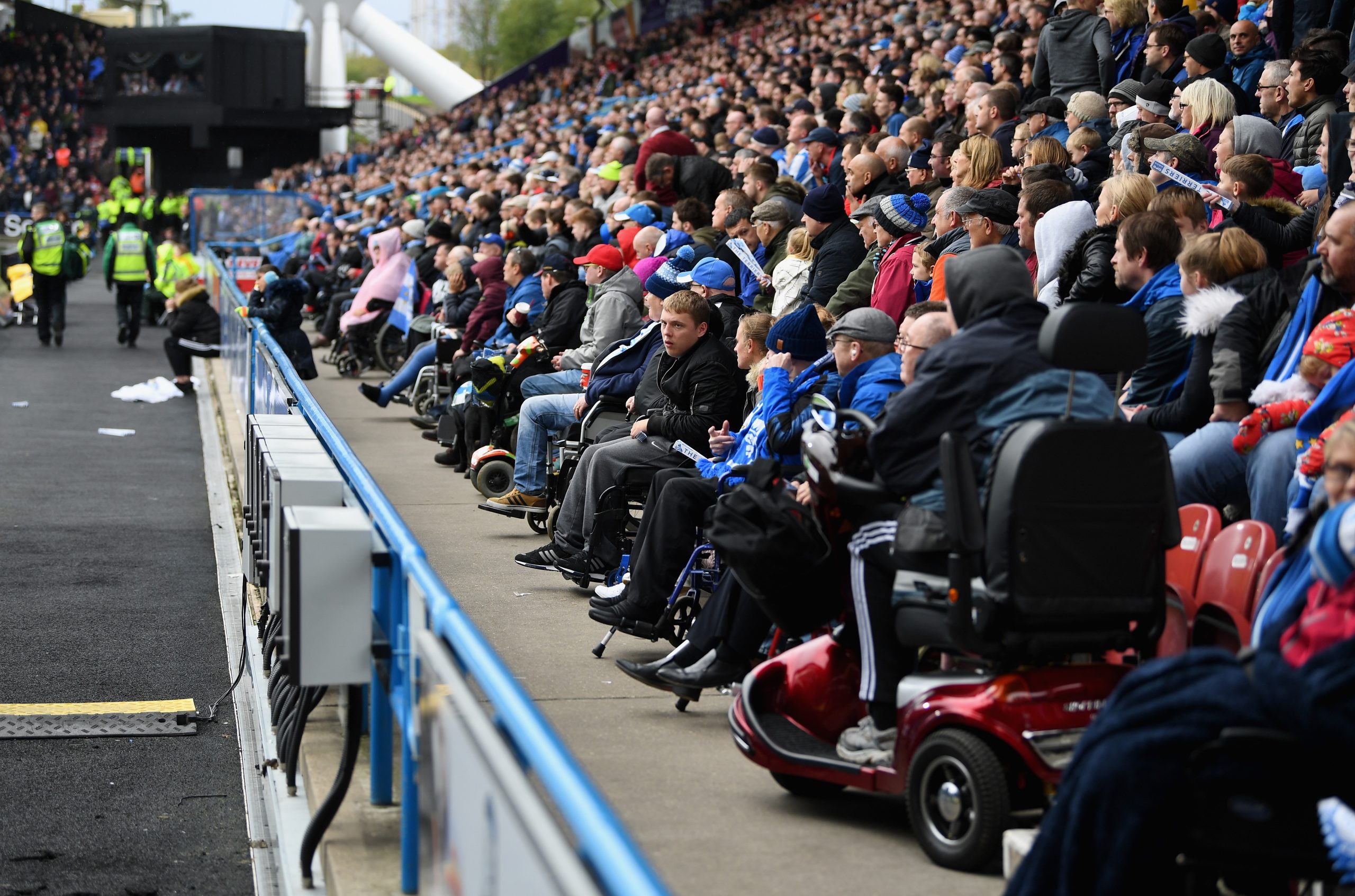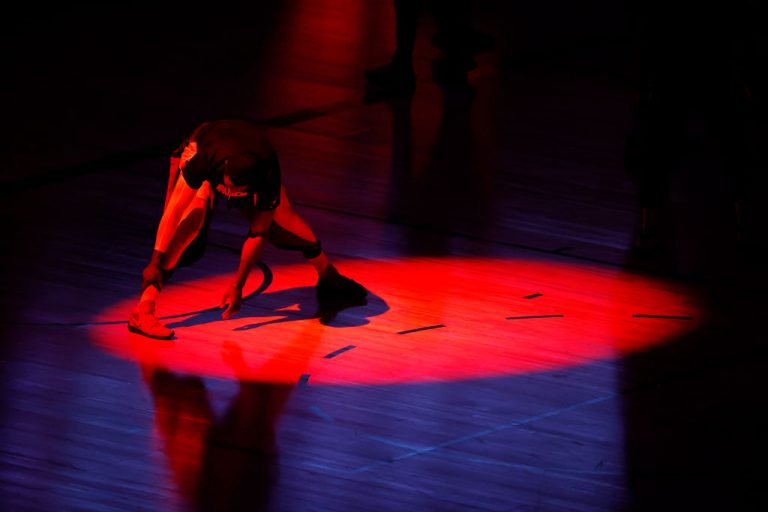The Sports World Risks Leaving Fans With Disabilities Behind As Live Games Return
Why this matters
The reality of disabled sports fans is extremely complex and for them, returning to the stadium is yet another obstacle to overcome when it comes to being included equally in society.
People with disabilities face many challenges in their day-to-day lives. They also face a greater risk of contracting COVID-19, a possibility that keeps them from enjoying activities such as attending sporting events. Merely enjoying a sporting event such as a soccer match now proves to be a challenge for disabled sports fans.
The Center for Access to Football in Europe (CAFE) recently published a report about the impact of COVID-19 on disabled sports fans. In a CAFE survey of over 400 fans with disabilities and people with long-term health conditions across Europe, 47 percent of the respondents had concerns about returning to stadiums, and other fans said that they have been advised by their doctors that it is not safe yet to return.
This greater risk comes from the barriers that this group faces to implement basic protection measures, such as sanitation, social distancing, access to public health information, and public transportation, among others. According to the World Health Organization and the United Nations, at least 1 billion persons have some type of disability. This represents 15 percent of the world's total population, with 80 percent of these persons living in developing countries. Even in normal circumstances, people with disabilities have to overcome obstacles to fully participate in the community. The COVID-19 pandemic has intensified the inequities between the populations with and without a disability.
To reduce the lack of social interactions, some clubs have contacted disabled fans to make them feel included during the pandemic. Global Sport Matters talked with some of those fans and with industry representatives, including María Castelló Talavera, Disability Access Officer (DAO) at Atletico de Madrid, where her role is to be a liaison between fans with disabilities and the club.
“When the lockdown started, we had just won against Liverpool, so we talked to them about the game (...) and also about their needs or the improvements that we could make – for example, at our museum – so that made them think about other things,” Castelló Talavera said.
Castelló Talavera mentioned that the club has been testing a return to the stadium at women's and men’s lower-category games. For these games, clubs in Spain are allowed to receive a reduced number of fans as long as the clubs implement specific precautions. Such games take place at one of Atletico's training facilities, the Centro Deportivo Alcala de Henares.
“We have invited some fans with disabilities to test our measures and see if they feel comfortable,” Castelló said, adding that the club will consider bringing back fans with disabilities once fans return to Wanda Metropolitano, if allowed.
As part of their social responsibility endeavors, Atletico de Madrid partnered with the Madrid Regional Government to transform the stadium into a vaccination venue.
Hear Castello Talavera discuss Atletico de Madrid's efforts to include their disabled fans in the return to live games:
GSM also contacted fans with disabilities to learn more about their concerns during the pandemic. Here in the United States, fans were able to go to some sporting events during the past year.
Gabe Trujillo, a native Arizonian, has been an electric wheelchair user since 1997 after becoming a quadriplegic. He shared his perspective on the pandemic as a sports fan, saying that, for him, it has been difficult to get through the pandemic.
“Most of my free time is spent either at sporting events or watching them, so to not have that during the pandemic was definitely difficult,” Trujillo said.
His family has been Arizona Cardinals season ticket holders for a long time. Despite some initial hesitation, they decided to attend a game at State Farm Stadium back in November, when COVID-19 social distancing restrictions were still in place.
“At that time, they were only allowing around 1,200 fans,” Trujillo said,” so one of the reasons why we decided to go and experience a game in person was because it was a giant stadium, a relatively open space, and they did a very good job of social distancing and implementing other procedures to make sure safety was a top priority.”
The safety measures in place were apparent when he attended the game, Trujillo said.
“Everyone was wearing masks. The stadium had cashless availability for food, and everybody was practicing social distancing. You were not allowed to take off your mask unless you were eating or drinking at the time. They also had sanitation stations and hand sanitizers spread out throughout the facility so people could utilize them,” Trujillo said.
Hear Trujillo discuss his experience as an NFL fan during the pandemic:
Gonzalo Palencia, an Argentinian with a physical disability and a ticket holder at Racing Club de Avellaneda, talked about his concerns for the post-COVID-19 scenario. Palencia has bigger concerns for when the club opens the stadium for fans.
“My first concern is that, after COVID-19 ends, the people who have to decide won’t forget that clubs have fans with disabilities. Because I imagine a possible scenario where stadiums will be open for 20 percent of the people, and they forget about us, not taking any special measures for people with disabilities to be safe to return to the stadium,” Palencia said, also pointing out, “Infrastructure is one of the most important issues because, for example, at El Cilindro, bathrooms are not well-adapted, and this is a crucial need.”
Nevertheless, Palencia wants to go back to the stadium.
“Since there are no long-term health conditions related to my disability, I would probably be able to attend the games, but I don’t see this happening in the first steps after COVID-19,” he concluded.
Hear Palencia discuss his worry that new amenities for disabled fans may be forgotten by sports teams:
In this sense, Daniel Prat, a former ticketing manager at Girona FC in Spain and part of the City Football Group, agreed.
“I wish I could say something different, but I think most sports properties will focus first on the traditional fan base, those who they usually had at the stadium before COVID-19. This will put fans with disabilities in second or third place,” Prat said.
Asked about a potential future strategy to attract this group of fans, Prat said: “It is not only important to give a secure experience but also to communicate it well.”
He said the need to feel secure at a soccer event would impact all the fans, but especially fans with disabilities because many of them may have a long-term medical condition and will need to feel safe at the stadium.
Hear Prat discuss why disabled sports fans may be left out of the return to live games:
Mito Dona has been working in the sports marketing industry in Venezuela, Central America, and the Caribbean for the past 17 years and is now based in Costa Rica as director of MercadeoDvo, an agency focused on data. He sees a variety of disparities and needs.
“There is a huge gap between the U.S. and all Latin American countries regarding the current reality of the pandemic. This is both vaccination-wise and in the amount of cases and people that have been hospitalized,” Dona said.
As a marketing expert, Dona said that bringing back disabled fans needs to be a big concern for sports properties. “Especially Gen Z and Millennials are interested in seeing what social responsibility activities their teams are engaging in, so they would want to know if there is nothing being done in the current situation for fans with disabilities,” he said.
Hear Dona discuss the discrepancy in recoveries among wealthy and developing countries:
When asked his thoughts about the situation of fans with disabilities in Venezuela, Dona said: “I don’t see fans returning to stadiums until the third quarter of 2022 because of the humanitarian crisis and non-existing vaccination process. The country hasn’t even started a massive vaccination of doctors and first-responders, so everybody else is months away from getting access to the vaccine.”
The bottom line is that the reality of disabled fans is extremely complex and that, for them, returning to the stadium is yet another obstacle to overcome when it comes to being included equally in society.
Monthly Issue
Now & Then: How Sport Has Transformed
For many, it’s been approximately a year in the life of a pandemic. We’ve seen tragedy, resilience, growing gaps of opportunity and opportunities for growth, juxtaposed in communities across the globe. The world of sport was not immune.
From a pause in play, to a push for more progressive racial justice, to unanswered questions about the long-lasting impacts of COVID-19 that still linger in the air - what do we wish we knew then, that we know now?




